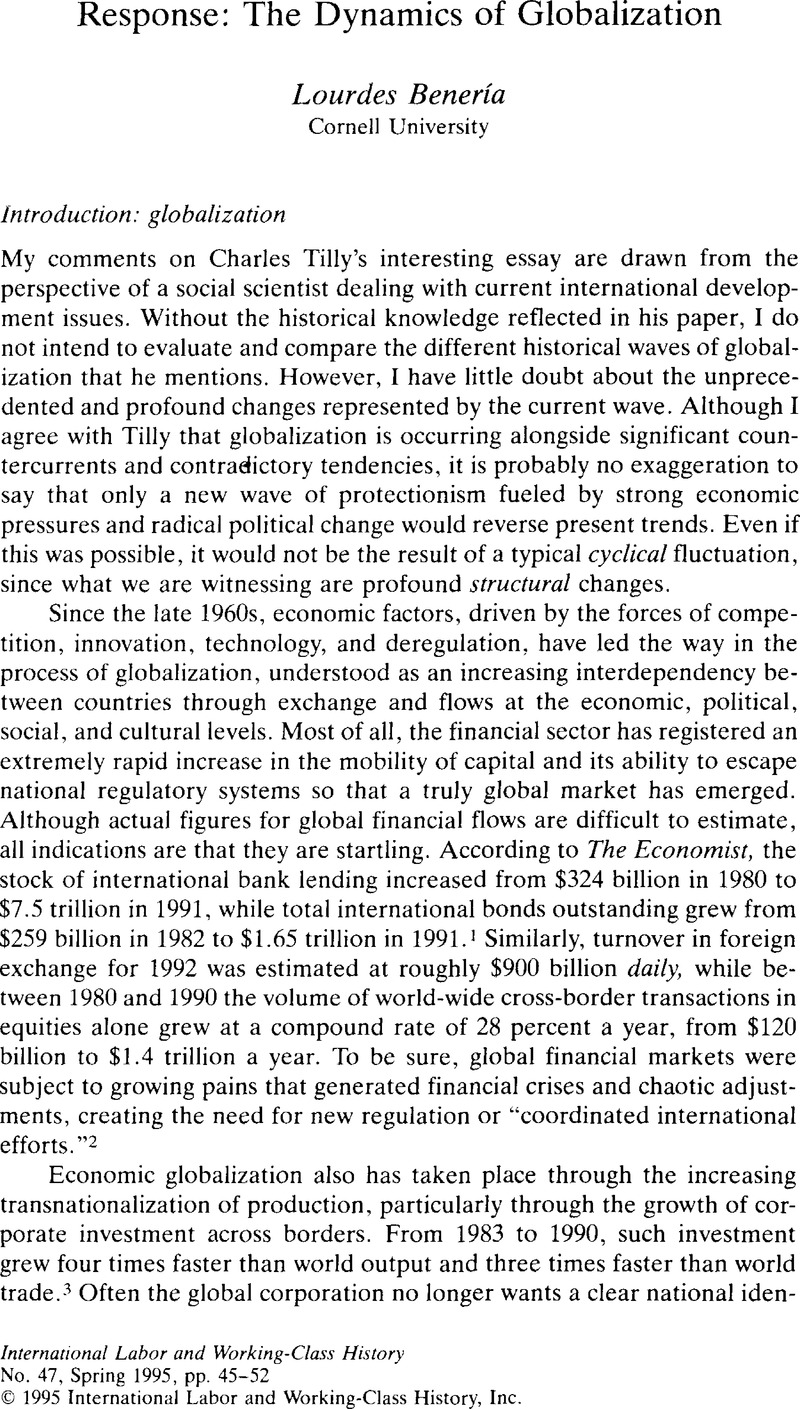Article contents
Response: The Dynamics of Globalization
Published online by Cambridge University Press: 16 December 2008
Abstract

Information
- Type
- Responses
- Information
- Copyright
- Copyright © International Labor and Working-Class History, Inc. 1995
References
NOTES
1. “World Economic Survey,” The Economist, September 19, 1992.
2. See Financial Derivatives. Actions Needed to Protect the Financial System, GAO report. GAO/GGD-94-133 (Washington, D.C., 05 1994).Google Scholar
3. “A Survey of Multinationals,” The Economist, March 27, 1993.
4. Much has been written about the way globalization increases the ability of transnational corporations to evade taxes either through transfer pricing or other means such as specific privileges and tax holidays negotiated with local governments. For an interesting analysis of these issues, sec “Mortgaging America.” World Policy Journal (Winter 1990–1991):27–59.Google Scholar
5. The literature on this subject is abundant. See, for example, U.S. Department of Labor. Bureau of International Labor Affairs, Worker Rights in Export Processing Zones (Washington. D.C., 1989–1990).Google Scholar
6. Even in countries where labor legislation incorporates a wide range of workers' rights, implementation of these rights is often lacking. Mexico is a notorious example that received much attention during the NAFTA negotiations.
7. For a debate on this issue, see Lim, Linda, “Capitalism, Imperialism and Patriarchy: The Dilemma of Third World Women Workers in Multinational Factories.” in Women, Men and the International Division of Labor, ed. Nash, J. and Fernandez-Kelly, M.P. (Albany, N.Y., 1983).Google Scholar The contradictory effects of transnational investment on women are also discussed in Ong, Aihwa. Spirits of Resistance and Capitalist Discipline: Factory Women in Malaysia (Albany, N.Y., 1987), and in numerous other sources.Google Scholar
8. U.S. Department of Labor. Worker Rights in Export Processing Zones.
9. For a discussion of this issue with regard to U.S–China tensions on human rights. see Madsen, Richard, et al. , Economic Development and Human Rights in China's Interior (New York, 1993).Google Scholar
10. This issue was at the root of the debates around the Maastrich Treaty and recently emerged during the elections to the European Parliament on June 14. 1994. Ignacio Ramonet, “Qué Europa Construir,” Cuatro Semanas y Le Monde Diplomatique (July 1994).
11. One could not help but have this in mind, for example, during the general strikes organized by the main Spanish trade unions during the past few years to protest government policies toward labor market deregulation and flexibilization. This is, of course, not an argument against action but an argument to rethink it, keeping the forces of globalization in mind.
12. There is growing evidence that these trends have been observed in many high-as well as low-income countries. In the United States, it is well known that the 1980s saw a very pronounced increase in the gap between rich and poor. According to a recent Bureau of Labor Statistics report, while the top 25 percent of families saw their share of national income increase from 48.2 percent in 1980 to 51.3 percent in 1992, the bottom 25 percent saw it decrease from 7.6 percent in 1980 to 6.5 percent in 1992, the widest rich—poor gap since the Census Bureau began to record such data in 1947. Business Week, August 15, 1994.
13. On this issue, see Appelbaum, E. and Batt, R., The New American Workplace (Ithaca, 1994).Google Scholar
14. Business Week, August 15, 1994.
- 5
- Cited by

